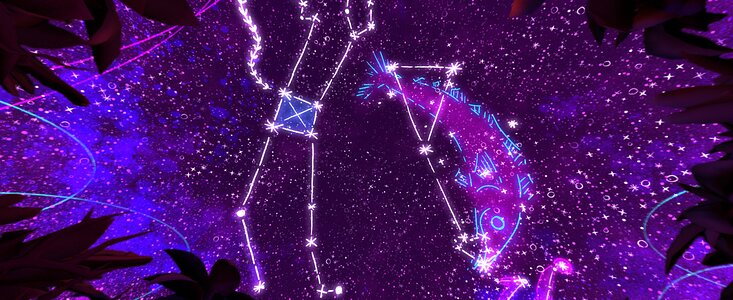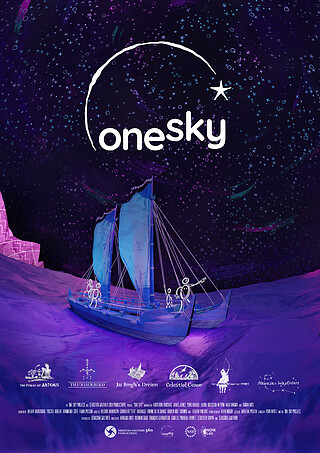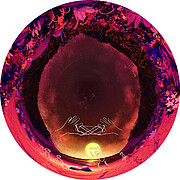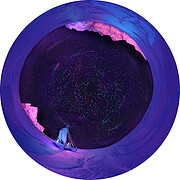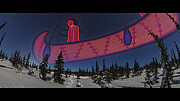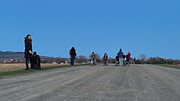International One Sky Project Highlights Importance and History of Indigenous Astronomy Through Film
Free-to-download planetarium series fosters cross-cultural understanding of humanity’s connection to the sky
9 June 2023
The One Sky Project, led by the ‘Imiloa Astronomy Center and sponsored by the Thirty Meter Telescope, has produced a series of seven short fulldome films and a compiled full-length feature film focusing on cultural and Indigenous astronomy. This international collaboration seeks to build cross-cultural connections and increase understanding of different indigenous perspectives while demonstrating how our one sky connects us all. The films, which received accolades in 2022 and 2023, are now free to download to planetariums around the world.
From the earliest days, people around the world have looked to the heavens for navigation, time-keeping, and a sense of shared identity. Modern audiences can benefit from learning how celestial knowledge has helped people live in this world for millennia, reach new lands, and treasure the cultural importance of a shared sky.
In an effort to foster greater understanding of humanity’s connection to the sky, the One Sky Project, which is led by the ‘Imiloa Astronomy Center, sponsored by the Thirty Meter Telescope, and supported by the California Academy of Sciences, the Franklin Institute, NSF’s NOIRLab, and the Thirty Meter Telescope, has released a series of seven short fulldome films and a compiled feature film focusing on cultural and Indigenous astronomy. The project is an international collaboration that seeks to build cross-cultural connections and increase understanding of different Indigenous perspectives while demonstrating how our one sky connects us all. The films are now free to download to planetariums around the world.
The concept for each film was conceived by the One Sky Project partnership to showcase the ways different cultures see and interpret humanity’s shared sky. The One Sky Project collaborative was convened in the summer of 2019 and involved astronomers, planetarium professionals, educators, and cultural experts from Canada, China, India, Japan, and the United States. The collaborative partners were integral in selecting the content of the films, drafting scripts, and connecting the production team to artists, musicians, and narrators. The diverse creative team of award winning Montréal-based fulldome production company Sébastien Gauthier 360 brought the collaborative’s research and ideas to life in remarkable ways.
Each short film represents the perspective of a different culture or Indigenous society from around the globe and can stand alone as a short story or be presented in combination with other One Sky Project films as a longer narrative. The films’ modular designs allow them to be easily integrated into topic-specific live presentations, providing planetariums with the flexibility to share stories that are most relevant to their local communities and visitors.
The films include:
- Celestial Canoe (Innu land, Canada)
The First People of what is now northern Canada watched the slow turn of a canoe in the sky — mirroring the change in seasons on land. This celestial canoe guided them through a particularly challenging part of the year.
- Hawaiian Wayfinders (Hawaiʻi, USA)
Hear from a Hawaiian navigator-in-training as she describes how the sky provides a compass and calendar for the oceanic people whose voyages connected islands throughout the Pacific Ocean.
- Jai Singh’s Dream (India)
Amid the political chaos of 18th-century India, a great ruler brought the order of the skies down to earth. His giant instruments allowed for precise measurements of stars, planets, and the passage of time — and his observatories still stand today.
- The Samurai and Stars (Japan)
For many, the stars offer solace and comfort. For our Japanese narrator, images in the sky — even the colors of the stars — bring back memories of music, history, and childhood.
- Thunderbird (Navajo Land, USA)
The sky is a powerful tool for measuring time, and for the Diné, or Navajo people, the Thunderbird transcends space and time, revealing the passage of seasons and connecting earth and sky.
- The Forge of Artemis (Greece)
In ancient Greece, Orion was a mighty but not particularly popular hunter, and his constellation shines brightly — a familiar shape to people around the world. Why did the goddess Artemis immortalize him in the sky?
- One Sky Epilogue
This short film rounds off the series of One Sky Project short films.
Ka‘iu Kimura, the Executive Director of the ‘Imiloa Astronomy Center of Hawai‘i, said “I think our Universe, our cosmos, is so enormous and expansive, that to say that there is only one way to connect to it is a complete disservice to its magnitude and grandeur. To have people learn about how other peoples connect to the cosmos adds to the vibrancy and depth of our world and the many cosmic perspectives represented therein. I’m hoping that this project will further advance Indigenous voices, and also better inform international science.”
Ryan Wyatt, lead scriptwriter, Senior Director of Morrison Planetarium and Science Visualization at the California Academy of Sciences, and One Sky Project participant added: “With the One Sky Project, we hope to shape the ways we communicate these important stories. The planetarium community has the responsibility to amplify Indigenous knowledge with authenticity and respect, and this project does its best to dive into that role.”
The One Sky Project recognizes our world’s many cultures and communities with strong connections to the stars. Traditional knowledge and practice continue to inform the active exploration of our Universe today and we honor those societies and Indigenous explorers who came first. This project seeks to build relationships within and between all people who share our one sky.
One Sky Project was recognized as the Best 2D Fulldome who in 2022 at the Fulldome Festival Brno in Czech Republic and Highly Commended at the 2023 Dome Under Festival in Australia.
More information about the One Sky Project and the collaborative is available on the newly redesigned website at: www.oneskyproject.org.
More information
TMT sponsored the One Sky Project. The ‘Imiloa Center for Astronomy was the convening nonprofit organization that invited and convened the partners for this effort. The One Sky Collaborative is thankful for the support and autonomy to advance every aspect of the films in the ways that are fully realized by what you will experience in the planetarium.
NSF’s NOIRLab (National Optical-Infrared Astronomy Research Laboratory), the US center for ground-based optical-infrared astronomy, operates the International Gemini Observatory (a facility of NSF, NRC–Canada, ANID–Chile, MCTIC–Brazil, MINCyT–Argentina, and KASI–Republic of Korea), Kitt Peak National Observatory (KPNO), Cerro Tololo Inter-American Observatory (CTIO), the Community Science and Data Center (CSDC), and Vera C. Rubin Observatory (operated in cooperation with the Department of Energy’s SLAC National Accelerator Laboratory). It is managed by the Association of Universities for Research in Astronomy (AURA) under a cooperative agreement with NSF and is headquartered in Tucson, Arizona. The astronomical community is honored to have the opportunity to conduct astronomical research on Iolkam Du’ag (Kitt Peak) in Arizona, on Maunakea in Hawai‘i, and on Cerro Tololo and Cerro Pachón in Chile. We recognize and acknowledge the very significant cultural role and reverence that these sites have to the Tohono O’odham Nation, to the Native Hawaiian community, and to the local communities in Chile, respectively.
Contacts
Kuʻulei Bezilla
ʻImiloa Astronomy Center of Hawai'i
University of Hawai'i at Hilo, Ph: 808.932.8924
Email: jbezilla@hawaii.edu
Sébastien Gauthier
Sébastien Gauthier 360
Email: alpha@cosmagora.ca
Kaʻiu Kimura
University of Hawai‘i
Email: lesliek@hawaii.edu
Jeanette Peach
California Academy of Sciences
Email: jpeach@calacademy.org
Ryan Wyatt
California Academy of Sciences
Email: rwyatt@calaademy.org
Charles Blue
Public Information Officer
NSF’s NOIRLab
Tel: +1 202 236 6324
Email: charles.blue@noirlab.edu





